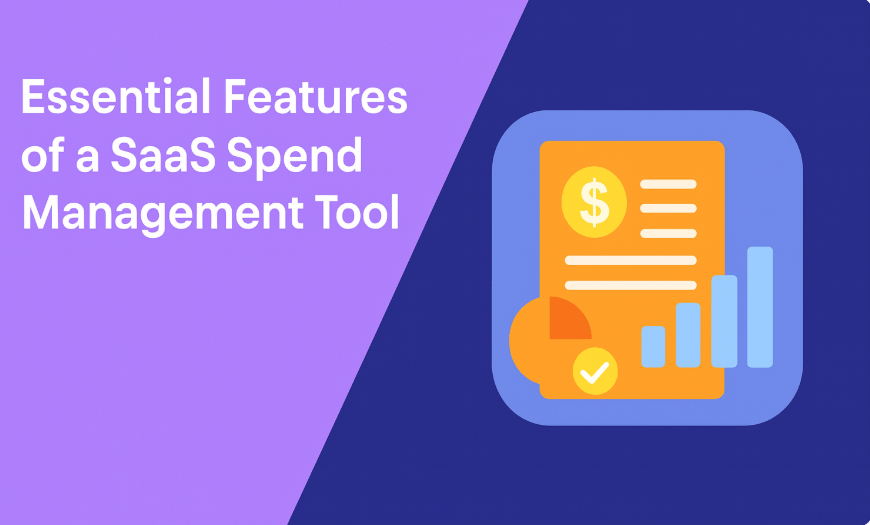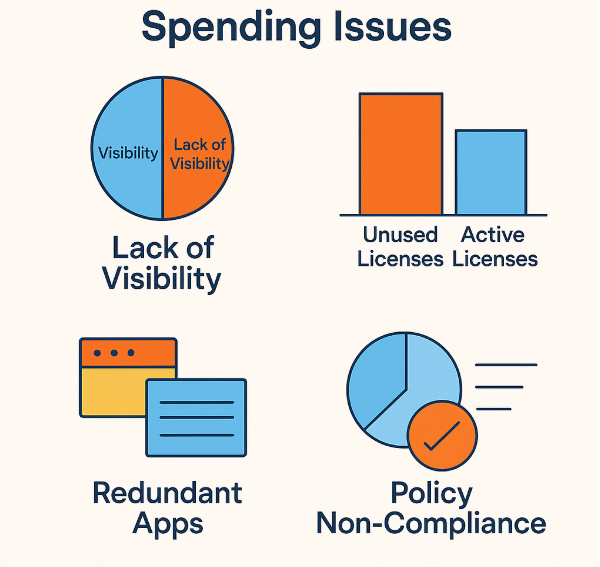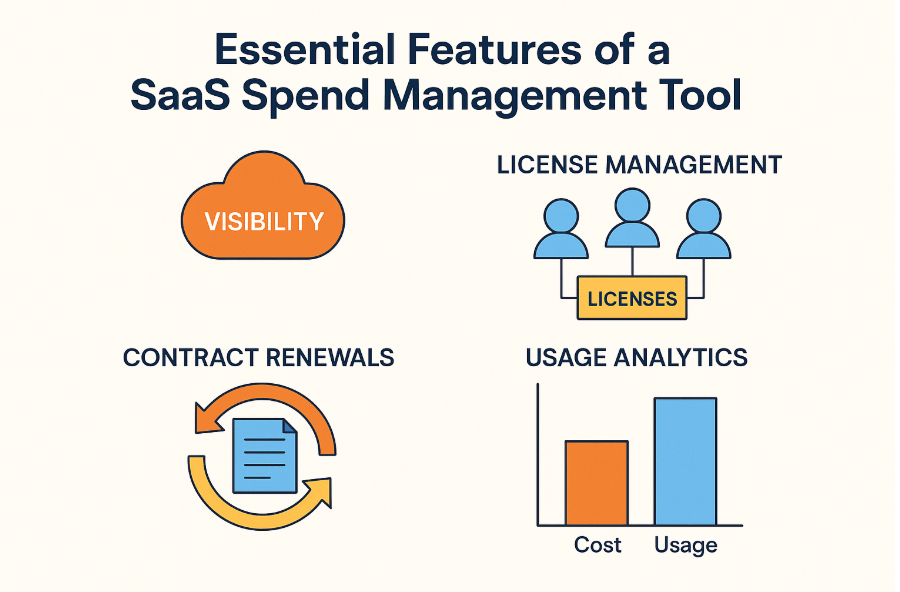
Introduction & Why These Features Matter
In an era when nearly every business function depends on cloud apps—from sales automation to HR platforms to collaboration tools—SaaS adoption has become both an opportunity and a cost center. Organizations often end up with dozens or even hundreds of subscriptions, many of which overlap in function, remain underused, or auto-renew without anyone noticing. The cumulative cost is large, not just in dollars, but in wasted effort, unmanaged risk, and lost negotiating leverage.
That’s where having a strong SaaS spend management tool comes in. Such a tool isn’t just a dashboard—it’s a comprehensive system designed to give you visibility, enforce accountability, automate tedious tasks, and ultimately bring your SaaS costs in line with real usage and business value.
In this article, we’ll walk through the essential capabilities you should expect in any serious SaaS spend management solution. We’ll cover what features solve which problems, how they support best practices, and key trade-offs to keep in mind.
Key Problems These Features Solve
Before diving into what features to look for, it helps to understand the common SaaS-cost problems organizations face. Matching features to real pain points leads to better outcomes.
- Shadow SaaS & visibility gaps: Many teams sign up for tools without IT, legal or procurement knowing. Over time, this creates “shadow” apps that aren’t tracked, monitored, or evaluated.
- Over-licensing and under-use: Companies often pay for more licenses or higher plan tiers than needed. Some users barely log in or use only a fraction of the tool’s features.
- Renewal surprises and contract inefficiency: Auto-renewals, confusing contract terms, or misaligned start/end dates can lead to waste. Without a centralized way to monitor contracts, cost savings or better negotiation terms slip through.
- Departmental silos and cost allocation confusion: If Procurement, IT, Finance, and individual departments aren’t aligned, billing becomes messy. It’s not clear who owns which cost or who’s responsible when a tool is downgraded or cancelled.
- Manual, error-prone processes: Spreadsheets, email threads, individual approvals—these slow you down and often miss something: unused licenses, policy violations, or compliance gaps.
When a SaaS spend management tool has the right features, it tackles these issues directly: giving end-to-end visibility, automations for tracking/renewals, tools to enforce policy, and analytics to back up decisions.

Visibility & Discovery
The most fundamental feature of any SaaS spend management tool is the ability to reveal what’s really happening across the organization. Without clear visibility, cost control and governance become guesswork.
A strong solution provides an automatic discovery engine that scans across multiple data sources—corporate credit card charges, single sign-on systems, HR directories, and even employee browsers—to detect every application in use. This ensures that not only sanctioned tools but also shadow IT apps are brought into view.
Once discovered, the tool should build a centralized application inventory that lists each SaaS platform with details such as owner, department, subscription plan, license count, cost, and renewal date. With this data, IT and finance leaders can quickly spot duplicate apps, unused licenses, and potential security gaps.
Real-time or near real-time updates are equally important. SaaS subscriptions are fluid: a new employee might sign up for a tool today, or a department could cancel one tomorrow. A discovery system that only refreshes once a quarter risks leaving you blind to important changes.
The payoff is straightforward: when you know exactly which applications exist, how they’re used, and how much they cost, you gain the foundation to reduce waste, negotiate better contracts, and ensure compliance. In other words, visibility and discovery are the gateway to every other feature in SaaS spend management.

License, User & Access Management
After visibility comes control. Once you know which SaaS applications are in play, the next step is ensuring that licenses and access are aligned with real usage. Without this, companies often overspend on seats that sit idle or grant privileges that create unnecessary security risks.
A strong SaaS spend management tool continuously tracks who has a license, how often they use it, and at what level. For example, if a marketing analyst logs into a premium analytics platform only once a month, that seat might be downgraded to a cheaper plan—or reassigned to someone who will get more value out of it.
Another critical capability is role-based access control (RBAC). By aligning license assignments with job functions, the tool prevents overprovisioning and limits unnecessary exposure. Sales leaders might get advanced CRM features, while interns receive basic access. This approach not only cuts costs but also strengthens compliance.
Equally valuable is employee lifecycle management. Onboarding and offboarding often create gaps where licenses linger unclaimed after someone leaves, or new hires wait too long to get the tools they need. Automation here ensures that as soon as HR marks an employee as terminated, their SaaS accounts are revoked, freeing those licenses for reuse. Similarly, when a new hire joins, the system automatically provisions the appropriate set of tools.
The result is a streamlined, accountable environment where every license is justified, every user has the right level of access, and the business avoids both overspending and unnecessary security risks.
Cost & Usage Analytics
Visibility and contract control set the stage, but true optimization comes from analyzing how applications are used versus what they cost. A SaaS spend management tool should provide deep insights into usage patterns and link them directly to financial impact.
This means tracking metrics like active versus inactive users, login frequency, and adoption of premium features. If a tool is expensive but only a handful of employees use it regularly, it may not justify the spend. Conversely, an application that looks costly at first glance may deliver strong ROI if it drives significant productivity across the organization.
Another crucial capability is cost allocation. A good platform doesn’t just show total spend—it breaks it down by department, team, or even individual user. This clarity encourages accountability and helps business leaders make informed decisions about which subscriptions to keep, expand, or cancel.
For finance leaders, trend analysis and benchmarking are equally important. A SaaS spend management tool should highlight how costs are evolving over time and, where possible, compare them to industry norms. This allows organizations to spot inefficiencies and negotiate better terms with vendors.
In short, cost and usage analytics transform raw data into actionable intelligence. They empower companies to shift from reactive cost-cutting to proactive, value-driven SaaS portfolio management.
Conclusion
The explosion of SaaS tools has brought agility and innovation to businesses—but also complexity, waste, and hidden risks. A strong SaaS spend management tool cuts through that complexity, delivering the features needed to gain control: visibility and discovery, license and access oversight, contract and renewal management, and usage analytics tied directly to cost.
When these features work together, organizations not only reduce wasteful spending but also strengthen security, compliance, and decision-making. The ultimate goal isn’t simply to save money—it’s to ensure every SaaS subscription actively supports business outcomes.
As SaaS adoption continues to grow, companies that embrace these capabilities will find themselves with leaner budgets, stronger governance, and a clearer path to innovation. Those without them risk being buried under layers of inefficiency and cost creep. The choice is simple: invest in the right SaaS spend management features now, and build a smarter, more sustainable digital future.

